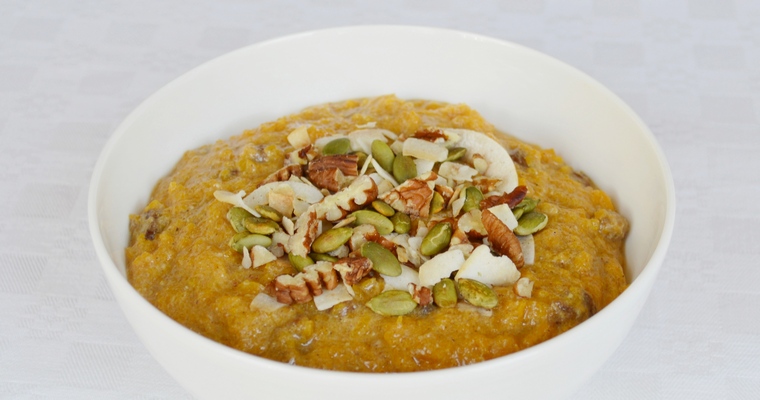Smooth, warming breakfast porridge made from pureed butternut squash and coconut milk infused with aromatic spices. Gluten-free, Dairy-free, Paleo and Vegan.
Porridge is usually understood to mean a grain-based dish in which oats, rice, barley, maize, rye or wheat are cooked in a pot with milk or water until they break down to form a creamy but textured mush. This breakfast dish evolved from a mainstay of the medieval diet called ‘pottage’. Before the advent of closed cooking ranges, meals were cooked in a pot suspended over an open fire. This was the true age of one-pot cooking. Liquid or semi-liquid dishes like soups and stews could be left unattended for large stretches of time while they cooked, as there was no danger of the bottom scorching. Indeed, a pot of pottage would be kept on the go for several days, constantly being topped up with more cereal, vegetables, meat or fish. So although the modern definition of porridge is restricted to a grain stew, the notion of vegetable porridge is not novel.
Butternut Squash (or pumpkin if you have the stamina to peel one!) makes an ideal porridge, as it is naturally sweet, and has a high-starch content. This means that is has a firm texture capable of retaining some bite – unlike watery vegetables like courgettes. But, unlike grains, vegetables do not contain enough starch to gelatinise the cooking liquid and create a thick consistency. For this reason, you need to add a thickening agent to pumpkin porridge. I used ground flax seeds, but, if you don’t have any in your cupboard, there are many alternatives that work just as well. Here is a list of alternative thickeners and toppings:
Tips & Tricks
- Preferably, use the neck end of a butternut squash – the base end is more fibrous and stringy
- Crush the cardamom pods until the husk splits open – this will release a stronger flavour from the seeds inside
- Toast the pecan nuts, pumpkin seeds and coconut chips separately – these brown at different rates
- Leave to stand for a few minutes before eating – porridge is notorious for holding its temperature, and high temperatures dull flavour (as well as burning your mouth!)
Ingredients
- Neck of a large squash, peeled and chopped into 2cm cubes (350g prepared weight)
- 1/2 can (200ml) coconut milk
- 100ml water
- 2 tablespoons ground flax seeds
- 1/2 teaspoon ground cinnamon
- 1/4 teaspoon ground ginger
- 1/4 teaspoon salt
- 50g sultanas
- 4 green cardamom pods, crushed with the broad side of a heavy knife
garnish:
- 30g pecans, roughly chopped
- 10g pumpkin seeds
- 10g coconut chips
Instructions
- Cook the butternut squash. Put the butternut squash in a steaming pan over a medium-high heat. Steam for 15 minutes, until more-or-less fork tender but retaining some bite. Alternatively, place in a bowl and microwave on full power for 3-4 minutes. Roughly mash with a potato masher, retaining a bit of texture, rather than reducing to a completely smooth puree. Set aside.
- Prepare the garnish. Meanwhile heat a dry frying pan over a medium heat. Toast the pecans, pumpkin seeds and coconut chips individually, rather than simultaneously in one big batch (they brown at different rates). Toast until lightly browned, shaking the pan frequently to avoid burning. Remove from the pan and set aside.
- Cook the porridge. Combine the liquid ingredients and ground ingredients in a saucepan (coconut milk, water, flax seeds, cinnamon, ginger and salt), and whisk together until blended. Add the sultanas and cardamom pods. Heat over a medium heat and bring to a simmer. As soon as it reaches a simmer, stir in the butternut squash. Continue cooking, stirring frequently, until thickened to a porridge-like consistency. Turn off the heat and leave to stand and cool for at least 5 minutes.
- Spoon the porridge into two bowls and scatter the garnish on top. If eating another day, leave to cool and then scrape into an airtight container. Refrigerate for up to 5 days. Reheat in a microwave, or by warming gently in a saucepan, stirring frequently (you may need to add a splash of water to loosen the mixture).


